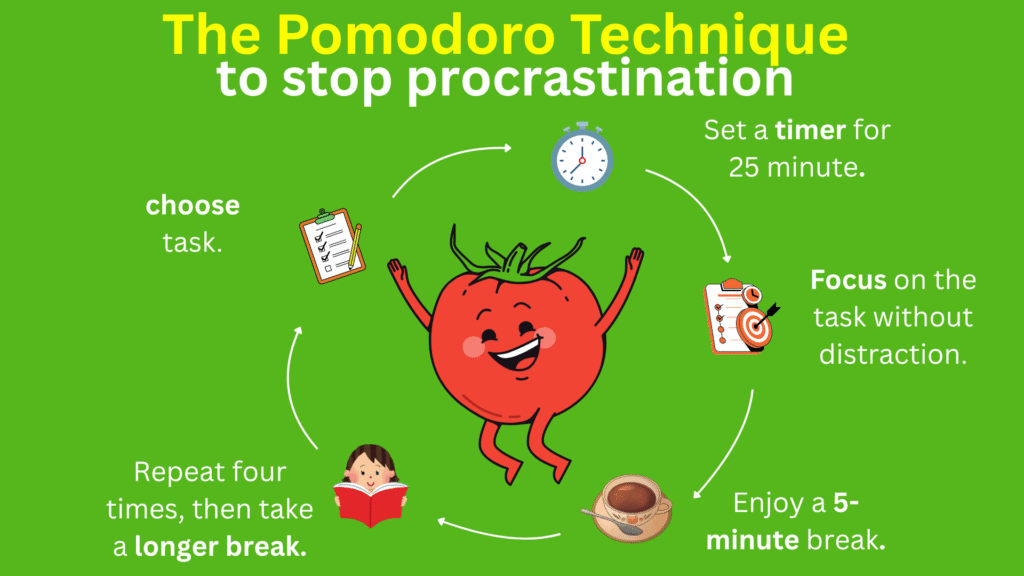What is the Pomodoro Technique?
One time management strategy that lets you work with time rather than against it is the Pomodoro Technique. Developed by Francesco Cirillo in the late 1980s, it gets its name from the tomato-shaped kitchen timer he used during university (“pomodoro” means tomato in Italian).
The idea is simple: you break your work into focused intervals, traditionally 25 minutes in length, separated by short breaks. We refer to each interval as a “Pomodoro.” Four Pomodoros later, you take a longer break. What I love about the Pomodoro Technique is its simplicity and structure. It turns time into a motivating force instead of a looming pressure. With just a timer, you can stay on track, keep distractions at bay, and get more done in less time.
Table of Contents
How Does It Work? My Step-by-Step Guide
Step 1: Choose Your Task(s)
Before starting, it’s crucial to know what you’re working on. For me, this clarity helps eliminate the hesitation that often leads to procrastination. Whether it’s writing an article or organizing files, I always choose one specific task.
Step 2: Set Your Timer (25 Minutes)
The 25-minute focused work interval is the core of the Pomodoro Technique I set a timer and commit to working on just that one task. If a distraction pops up, I write it down and get back to work immediately. This “inform and return” strategy really works!
Step 3: Work Until the Timer Rings
The Pomodoro Technique is one time management technique allowing you to work with time rather than against it.
myself fully in the task. Surprisingly, this short burst of time often helps me accomplish more than an hour of distracted effort.
Step 4: Have a Quick 5-Minute Break
When the timer rings, I stop—no matter what. These 5-minute breaks are small but powerful. I use them to stretch, grab a drink, or simply rest my eyes. It’s amazing how refreshed I feel after just a few minutes.
Step 5: Take a Longer Break (15–30 Minutes) Following Four Pomodoros
After four work intervals, I take a longer break. This is the time to truly recharge—walk outside, meditate, or eat something. These breaks prevent burnout and prepare me for another productive cycle.

Why I Believe the Pomodoro Technique Works (The Benefits)
Improved Focus and Concentration
Since adopting the Pomodoro Technique, I’ve noticed a significant increase in my ability to concentrate. With a clear timeframe and a ticking timer, I feel more compelled to stay on task.
Combats Procrastination
Starting is often the hardest part. But telling myself, “Just 25 minutes,” makes it easier. That low-pressure entry point helps me begin even the most daunting tasks.
Enhanced Time Awareness
I’ve developed a better sense of how long tasks really take. Over time, this has helped me plan my day more realistically and avoid overcommitting.
Reduced Burnout
Built-in breaks mean I no longer work until I’m mentally exhausted. Instead, I maintain a steady rhythm, which makes me more productive over the long haul.
Boosts Productivity
Overall, I’m getting more done—and feeling better about it. The Pomodoro Technique keeps me energized and prevents the mental fatigue that often accompanies long, unstructured work sessions.
Customizing the Pomodoro Technique: Making It Your Own
Adjusting Pomodoro Length
While 25 minutes is the standard, I sometimes use 30/10 or even 45/15 depending on the task. The secret is to be balanced and focused.
Varying Break Durations
Intense work might call for longer breaks. I adjust my break length to fit the energy demand of the task. Flexibility keeps the method sustainable.
Tools I Use
- Physical Timer: Sometimes I still use a real kitchen timer for the tactile feel.
- Smartphone Apps: These are convenient for setting intervals, tracking progress, and even blocking distractions.
- Online Timers: Great when working from a desktop. Simple and no installation needed.
Handling Interruptions
I use a notebook to jot down random thoughts or external interruptions. This helps me stay focused during a Pomodoro while ensuring I don’t forget anything important.
Batching Similar Tasks
Grouping related tasks (like replying to emails or editing content) into one Pomodoro helps me stay in the right mental zone and reduce the time lost switching contexts.
Who Can Benefit from the Pomodoro Technique? My ThoughtsStudents
Perfect for studying, writing assignments, and breaking large topics into manageable chunks.
Writers
Whether you’re drafting a blog or a novel, timed sprints keep the words flowing.
Remote Workers
Structure is vital when working from home, and Pomodoros offer the ideal framework.
Anyone Struggling with Focus
If you’ve ever caught yourself mindlessly browsing or jumping between tasks, the Pomodoro Technique can bring you back on track.
In conclusion, I urge you to experiment with the Pomodoro Technique.
The Pomodoro Technique may be simple, but its impact on productivity is profound. From managing distractions to staying energized throughout the day, I’ve found it to be one of the most effective strategies for time management.
To recap, this technique:
- Enhances focus
- Fights procrastination
- Promotes better time awareness
- Prevents burnout
- Boosts overall productivity
My honest recommendation? Try it. Try only one Pomodoro today and observe the results. The amount of work you do may surprise you. The Pomodoro Technique has changed the way I work, and I think it can change the way you work as well.